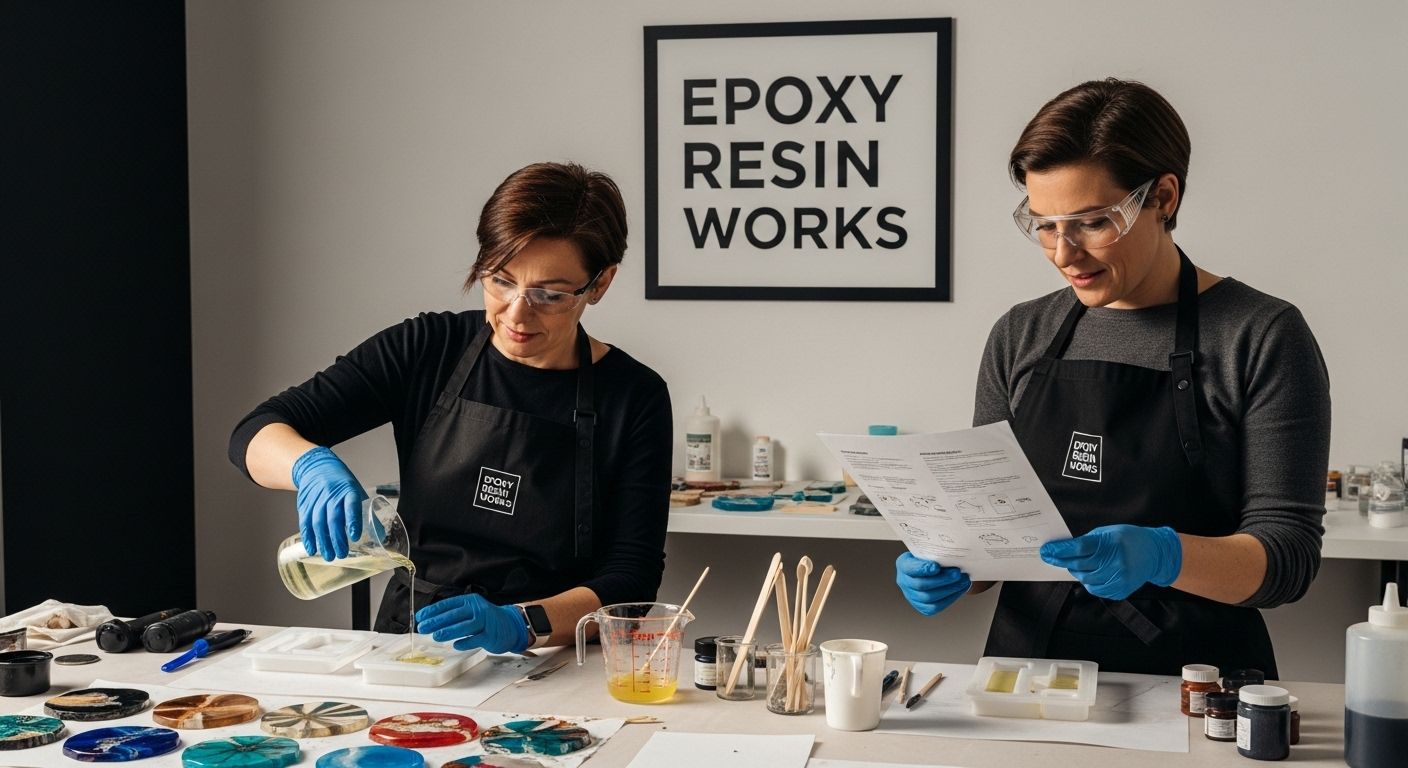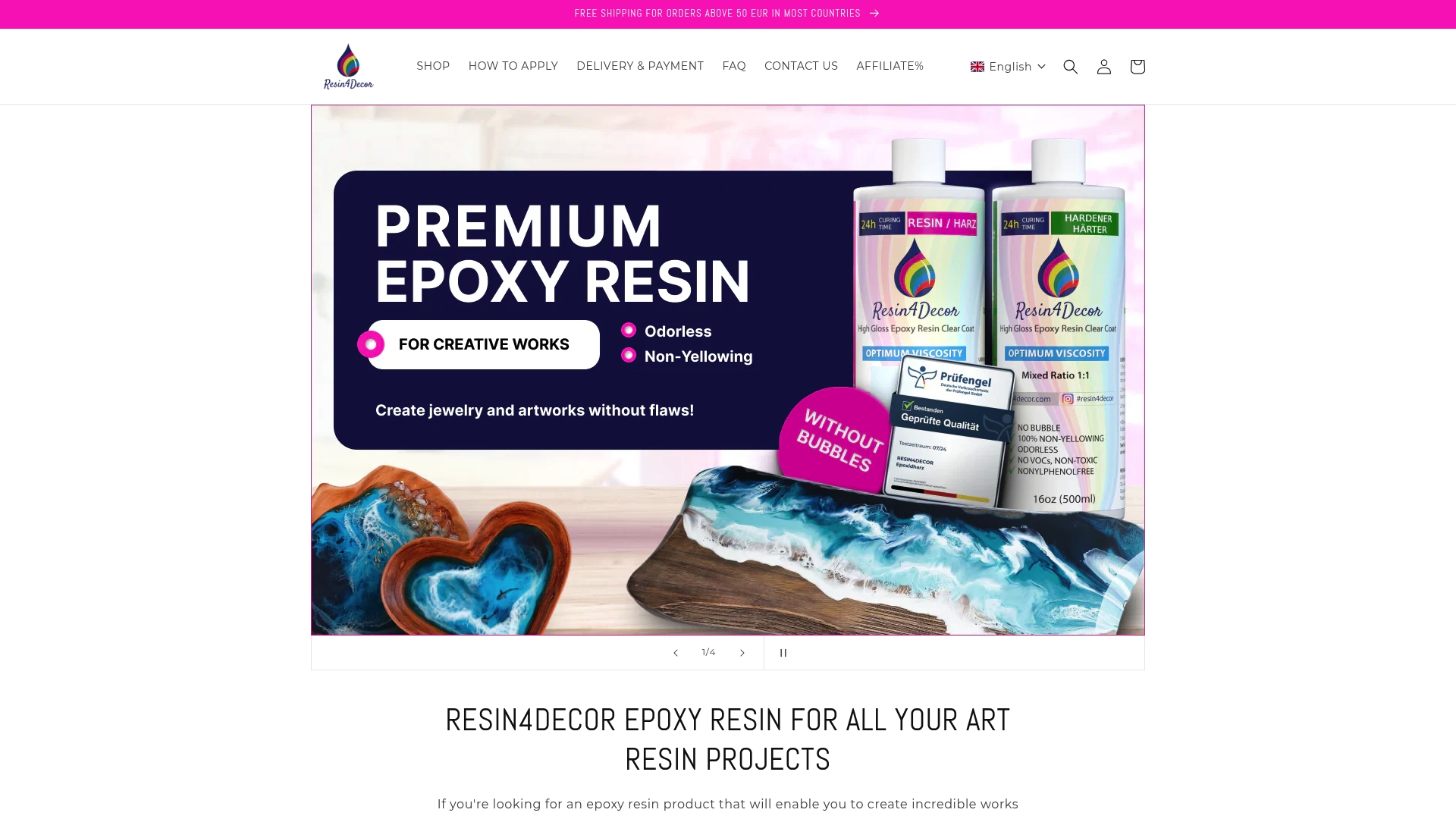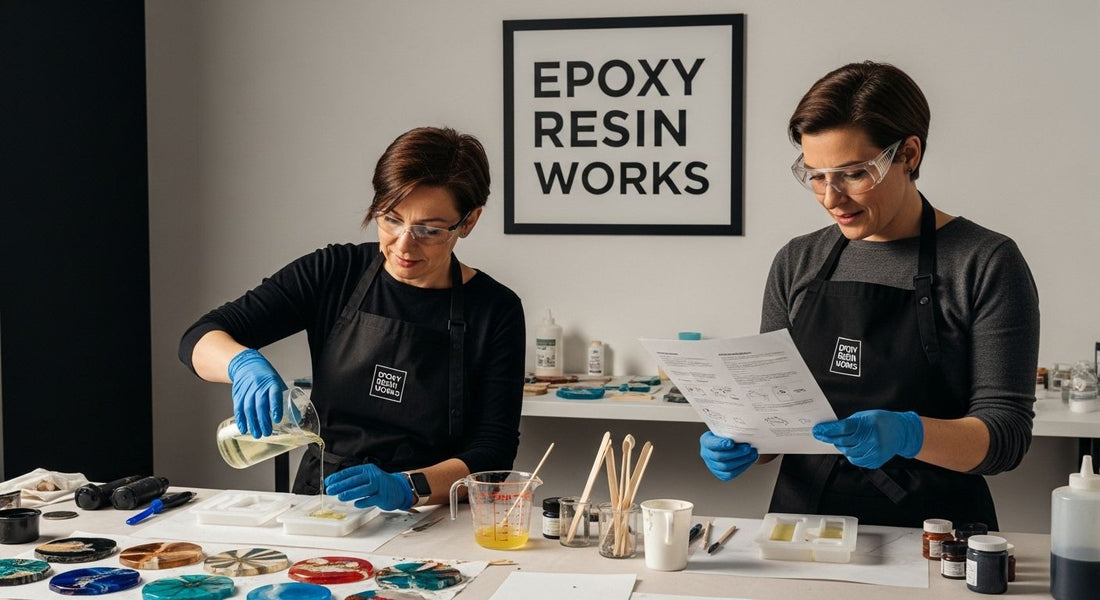
Epoxy resin has exploded in popularity across creative studios and small businesses throughout Europe. People are drawn to its striking glass-like finish and the power to turn simple materials into truly durable works. But here is something most creators miss. Even a small temperature change can make epoxy cure up to twice as fast or slow. Most folks focus on the final look, but the real secret to success lies in mixing it right and controlling the science behind the hardening process.
Table of Contents
- What Is Epoxy Resin And How It Hardens
- The Science Behind Mixing And Curing
- Key Uses For Artists, Crafters, And Businesses
- Essential Safety Tips For EU Resin Work
Quick Summary
| Takeaway | Explanation |
|---|---|
| Understand the chemical composition | Epoxy resin is made of resin and hardener, crucial for its hardening process. Proper mixing is vital for achieving desired properties. |
| Temperature affects curing speed | Warmer environments accelerate the curing process, allowing for optimal results in resin applications. Adjust your workspace conditions accordingly for best outcomes. |
| Use protective equipment and ventilation | Always wear safety goggles and gloves, and ensure proper ventilation to minimize health risks during resin work. Safety precautions are essential. |
| Follow precise mixing ratios | Accurate ratios of resin to hardener are critical for successful curing and strength. Always adhere to manufacturer instructions for the best results. |
| Explore artistic and functional applications | Epoxy resin can be used creatively in art and design, as well as in functional products like furniture and accessories, offering vast possibilities for creators. |
What Is Epoxy Resin and How It Hardens
Epoxy resin represents a remarkable synthetic material that transforms from a liquid state to a durable solid through a fascinating chemical process. At its core, epoxy resin is a versatile polymer system composed of two primary components: the resin itself and a hardener, which work together to create an incredibly strong and stable material.
The Chemical Composition of Epoxy Resin
Epoxy resins are essentially synthetic polymers characterized by epoxide groups in their molecular structure. These molecules contain reactive chemical bonds that enable them to undergo a unique transformation when mixed with specific hardening agents. According to Wikipedia, the curing process involves a chemical reaction where polyamines typically trigger the ring-opening of epoxide groups, creating a complex three-dimensional network.
The fundamental chemistry behind epoxy resin is remarkably precise. When the resin and hardener are combined, they initiate a process called cross-linking. This reaction causes the liquid molecules to interconnect, forming an incredibly strong and rigid structure. National Center for Biotechnology Information research highlights that this transformation involves significant microstructural changes, converting the material from a fluid state to a solid, dimensionally stable substance.
The Hardening Process: From Liquid to Solid
The hardening of epoxy resin is an exothermic chemical reaction that generates heat as the molecules bond. This process is not simply about drying or cooling but represents a fundamental molecular restructuring. When the resin and hardener are mixed, their chemical components begin an intricate dance of molecular interactions. The reaction can be accelerated by temperature and catalysts, allowing creators to control the curing speed and characteristics of the final product.
The curing process typically involves several critical stages. Initially, the mixture remains workable, allowing artists and craftspeople to shape and manipulate the material. As the chemical reaction progresses, the resin gradually becomes more viscous. Eventually, it transitions into a completely solid state, forming a durable, glass-like material with exceptional strength and resistance to environmental factors.
Temperature plays a crucial role in this transformation. Warmer environments can speed up the curing process, while cooler temperatures slow it down. Professional creators often use controlled heating techniques to optimize the hardening process, ensuring consistent results and minimizing potential imperfections in their final work.
Understanding how epoxy resin works is essential for anyone interested in creating with this incredible material. Its unique ability to transform from a liquid to a solid through a precise chemical reaction makes it an invaluable tool for artists, designers, and craftspeople across various disciplines. Whether used for creating jewelry, artwork, industrial components, or decorative pieces, epoxy resin offers an unparalleled combination of versatility and durability.
The Science Behind Mixing and Curing

The process of mixing and curing epoxy resin is a precise scientific endeavor that requires careful attention to detail and understanding of complex chemical interactions. Professional creators and artisans must master these techniques to achieve optimal results in their projects.
Precision in Mixing Techniques
Mixing epoxy resin is far more than simply combining two liquids. According to Harvard University’s Graduate School of Design, the recommended approach involves dispensing equal parts of resin and hardener onto a clean surface and mixing thoroughly for 1-2 minutes. Research from the National Center for Biotechnology Information reveals that using a dispersing disc mixer at 460 rpm for 3 minutes, combined with careful deaeration, can significantly improve the tensile strength of the final cured material.
The mixing process demands meticulous attention to several critical factors. Ratio accuracy is paramount, with most epoxy systems requiring precise 1:1 or 2:1 resin-to-hardener proportions. Temperature also plays a crucial role, as both components should be maintained at a consistent ambient temperature to ensure uniform mixing and optimal chemical interaction.
The Complex Curing Process
Curing is a sophisticated chemical transformation that goes beyond simple solidification. Research published in the journal Polymers demonstrates that curing time and temperature dramatically impact the final material properties. Professional creators typically control this process by maintaining base and curing agents at a consistent temperature and mixing them for a precise duration.
The curing process involves several distinct stages. Initially, the mixed resin remains workable, allowing for manipulation and shaping. As chemical bonds form, the material gradually becomes more viscous. During this phase, molecular chains begin to cross-link, creating a three-dimensional network that provides exceptional strength and durability.
Temperature control is critical during curing. Warmer environments accelerate the chemical reaction, while cooler temperatures slow it down. Experienced artisans often use controlled heating techniques to optimize the curing process, ensuring consistent results and minimizing potential imperfections.
Safety remains a paramount concern throughout the mixing and curing process. Proper ventilation, use of personal protective equipment, and understanding the chemical interactions are essential for both professional and hobbyist creators. The science behind epoxy resin is a delicate balance of chemistry, precision, and technique - transforming liquid components into a solid, incredibly versatile material that opens up endless creative possibilities.
To help clarify the important steps and factors in the epoxy mixing and curing process, the table below summarizes the key procedures and considerations for best results:
| Step | Key Considerations | Recommendations |
|---|---|---|
| Measure resin & hardener | Use precise ratio (e.g., 1:1 or 2:1) | Follow manufacturer’s guidelines |
| Mix thoroughly | Mix for 1-2 minutes (manual) or 3 minutes at 460 rpm | Use clean tools and surface |
| Deaerate | Remove trapped air | Use slow stirring, allow resting before pouring |
| Temperature management | Consistent temperature for both components | Maintain room temp (20-25°C) |
| Curing | Monitor time and environment | Warmer environments speed up, cooler slow down |
| Safety precautions | PPE, ventilation, clean workspace | Goggles, gloves, ventilate area |
Key Uses for Artists, Crafters, and Businesses
Epoxy resin has revolutionized creative industries, offering unprecedented versatility for artists, crafters, and businesses across multiple domains. Its unique properties enable creators to transform ordinary materials into extraordinary pieces with remarkable durability and aesthetic appeal.
Artistic Applications and Creative Expression
Artists have discovered epoxy resin as a transformative medium for creating stunning visual works. According to Chemical Safety Facts, epoxy resins can be used to design paintings, jewelry, and intricate castings. Artists can embed natural materials like flowers, plants, and stones within resin, creating three-dimensional artworks that capture and preserve delicate organic elements.
Painting techniques with epoxy resin have emerged as a cutting-edge artistic approach. By layering pigmented resins, artists can create mesmerizing depth and translucency in their compositions. Wikipedia research highlights that artists can pour multiple layers to form complete pictures, achieving unique visual effects impossible with traditional painting mediums.
Functional Design and Industrial Applications
Beyond artistic endeavors, epoxy resin plays a crucial role in functional design and industrial applications. Wood-epoxy resin artifacts have become particularly popular, with creators developing innovative pieces like river tables where resin fills gaps between wood slabs, creating stunning furniture with organic, flowing designs.
Businesses and craftspeople utilize epoxy resin for various practical purposes. From creating decorative countertops and serving trays to developing structural components and specialized accessories, the material offers exceptional versatility. Its ability to be molded into various shapes and provide a seamless, glossy finish makes it ideal for modern design styles ranging from industrial to rustic and eclectic.
Commercial and Professional Opportunities
The versatility of epoxy resin has opened numerous commercial opportunities for small businesses and independent creators. Jewelry makers can craft unique, durable pieces with intricate designs. Furniture designers can produce statement pieces that blend natural materials with synthetic elegance. Boutique craftspeople can develop specialized products like cutting boards, decorative trays, and miniature accessories that showcase the material’s exceptional properties.
Professional creators appreciate epoxy resin’s capacity to withstand various temperatures and provide long-lasting durability. Its protective qualities, such as resistance to ultraviolet light, make it an excellent choice for preserving and enhancing artistic and functional creations.
From intricate art pieces to functional design elements, epoxy resin continues to push the boundaries of creativity. Its unique combination of aesthetic flexibility, durability, and transformative potential makes it an invaluable material for artists, crafters, and businesses seeking to create something truly extraordinary.
To better visualize the diverse uses of epoxy resin for different types of creators, here is a table summarizing key applications and benefits:
| User Type | Key Applications | Benefits & Features |
|---|---|---|
| Artists | Paintings, jewelry, castings, embedding organic objects | Unique effects, depth, preserves materials |
| Furniture Makers | River tables, countertops, serving trays | Durability, seamless finish, versatility |
| Businesses | Structural components, accessories, décor products | Scalability, modern design, strength |
| Craftspeople | Cutting boards, trays, miniatures | Customization, aesthetic appeal, originality |
Essential Safety Tips for EU Resin Work
Working with epoxy resin demands rigorous safety protocols to protect creators from potential health risks and ensure a safe creative environment. Understanding and implementing comprehensive safety measures is crucial for professionals and hobbyists alike.
Personal Protective Equipment and Workspace Preparation
The foundation of safe resin work begins with proper personal protective equipment (PPE) and workspace configuration. According to Harvard’s Graduate School of Design, creators must use specific protective gear including safety goggles, nitrile gloves, and long-sleeved clothing to minimize direct skin contact.
Workspace ventilation is critical. The European Agency for Safety and Health at Work emphasizes the importance of working in well-ventilated areas to reduce potential respiratory exposure. This means setting up your workspace near open windows, using extraction fans, or working in outdoor environments when possible.
Health Risks and Exposure Management
Uncured epoxy components present significant health risks that must be carefully managed. The Centers for Disease Control warns that direct skin contact or inhalation can lead to potential sensitization and dermatological issues. Immediate actions such as thorough skin washing and clothing changes are recommended if contamination occurs.
Recognizing potential allergic reactions is crucial. Some individuals may develop skin sensitization or contact dermatitis from repeated exposure. Monitoring your body’s response and using barrier creams can help mitigate these risks. Check our comprehensive safety guide for more detailed information on managing potential allergic responses.
Best Practices for Safe Resin Handling
Safe resin work extends beyond personal protection to include careful material handling and storage. Always read manufacturer instructions thoroughly before beginning any project. Store resin components in sealed containers, away from direct sunlight and extreme temperatures. Keep your workspace clean and organized, with dedicated areas for mixing, curing, and storing materials.
Temperature and humidity can significantly impact both resin performance and safety. Work in environments between 20-25 degrees Celsius with moderate humidity to ensure optimal curing conditions and minimize potential chemical instability.
For European creators, additional considerations include compliance with local safety regulations and chemical handling standards. Stay informed about the latest safety guidelines and continue educating yourself about best practices in resin work.
By implementing these comprehensive safety strategies, creators can confidently explore the incredible potential of epoxy resin while protecting their health and well-being. Remember, safety is not just a recommendation it is an essential part of the creative process.

Frequently Asked Questions
What is epoxy resin and how does it harden?
Epoxy resin is a synthetic polymer made of resin and hardener that transforms from a liquid to a solid through a chemical reaction known as cross-linking. This process involves the bonding of molecules to create a strong, durable material.
How does temperature affect the curing process of epoxy resin?
Temperature has a significant impact on the curing speed of epoxy resin. Warmer temperatures accelerate the curing, allowing for quicker results, while cooler temperatures slow down the hardening process. It’s important to control the workspace temperature for optimal outcomes.
What safety precautions should I take when working with epoxy resin?
When working with epoxy resin, always wear personal protective equipment (PPE) such as safety goggles and gloves. Ensure good ventilation in your workspace to minimize inhalation risks, and follow best practices for handling and storing resin to prevent exposure hazards.
How do I properly mix epoxy resin and hardener?
To mix epoxy resin and hardener effectively, measure the components accurately according to the manufacturer’s recommended ratios (typically 1:1 or 2:1). Mix thoroughly for 1-2 minutes, ensuring even distribution, and eliminate any air bubbles by using slow stirring or allowing the mixture to rest before pouring.
Turn Epoxy Knowledge Into Stunning Results—Shop Safe, Certified Resin Now
You just learned how temperature changes, accurate mixing, and proper safety measures all make or break your epoxy creations. Maybe you are facing issues with curing times or find yourself worried about hidden health risks from low-quality materials. If you want your art to shine and your workspace to stay safe, you do not need to experiment or risk disappointment. At Resin4Decor.com, every resin is certified safe, tested for the challenges EU creators face, and comes with clear instructions to help you avoid common curing mistakes. You will also discover a wide selection of pigments and handy accessories, plus real customer reviews demonstrating what is possible when you choose quality materials.

Shop today and unlock better results for your next project while enjoying fair prices and free shipping on qualifying orders. For EU artists who want to create with confidence and never worry about performance or safety, explore all our epoxy resin solutions at Resin4Decor.com and start your best project now.

